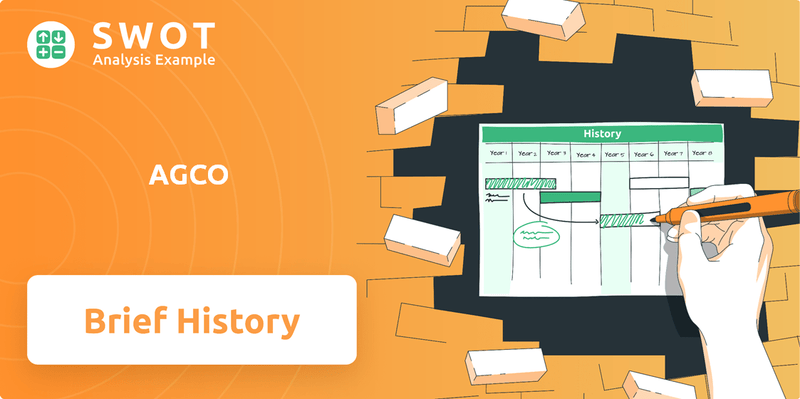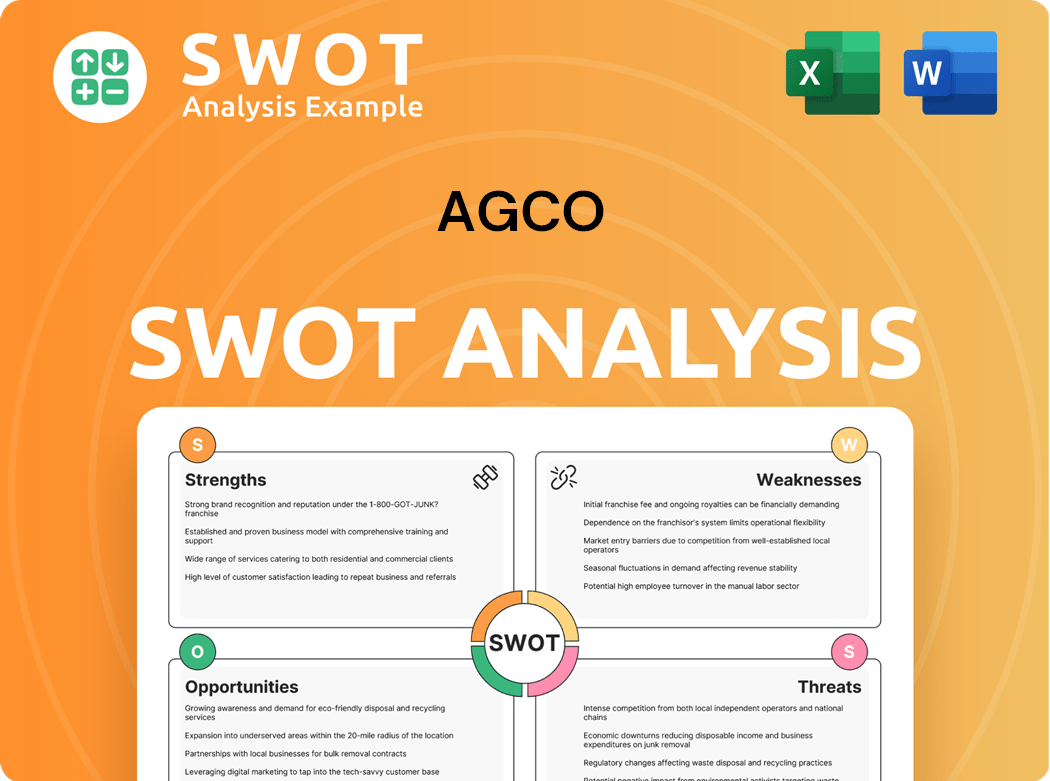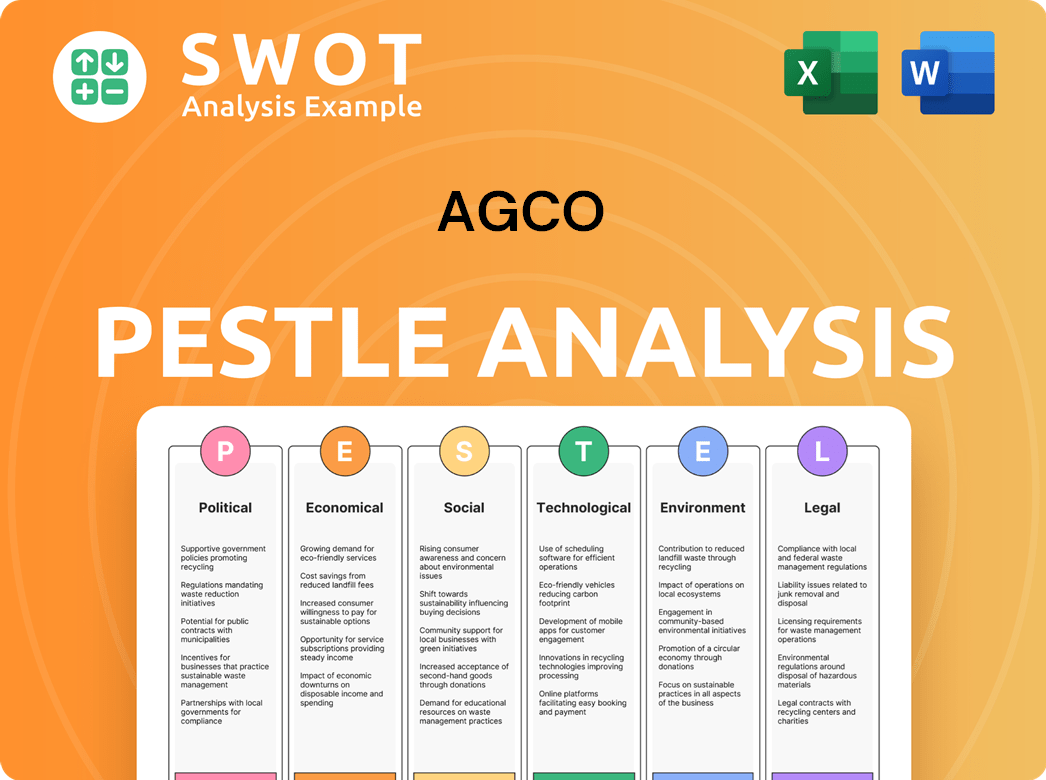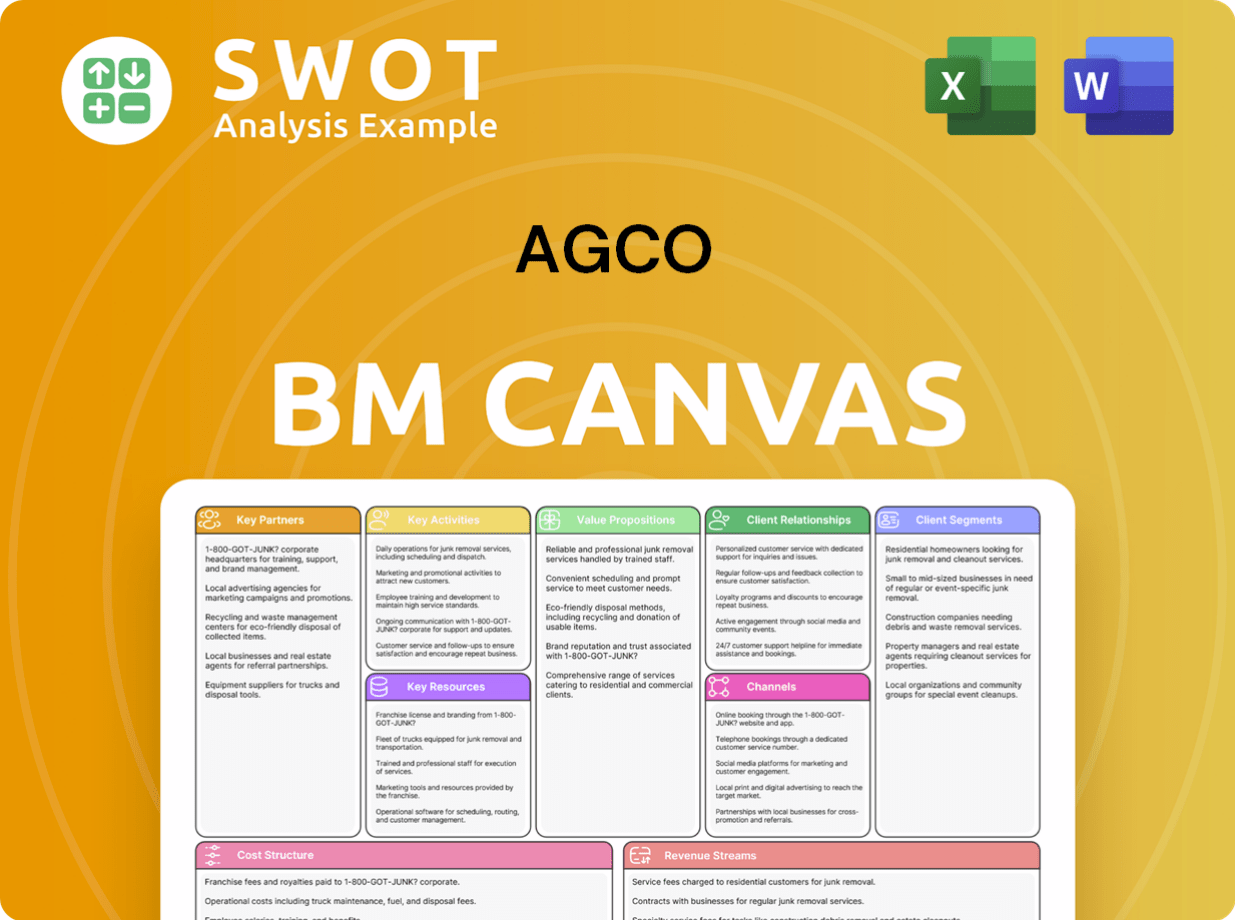AGCO Bundle
How Did AGCO Rise to Become an Agricultural Giant?
AGCO Corporation's story is one of remarkable growth, transforming from a collection of acquired businesses into a global leader in agricultural machinery. This AGCO SWOT Analysis is a testament to its strategic vision. Learn about the pivotal moments that shaped the

AGCO's journey, a brief history of AGCO Corporation, began with a strategic focus on acquisitions, allowing it to quickly build a diverse portfolio of AGCO brands and AGCO products. The company's commitment to innovation and its ability to navigate the complexities of the agricultural machinery market have been key to its success. Today, AGCO's global presence is a result of its ability to understand and respond to the needs of farmers worldwide, offering a comprehensive range of agricultural solutions.
What is the AGCO Founding Story?
The story of the AGCO company began on June 20, 1990. This marked the formal establishment of AGCO Corporation, born from a management buyout of the North American operations of Deutz-Allis.
The key players behind this pivotal moment were Robert J. Ratliff, John M. Shumejda, Edward R. Swingle, and James M. Seaver. These executives, already familiar with the agricultural machinery industry, saw potential where others saw challenges. Their vision set the stage for what AGCO would become.
AGCO's initial strategy focused on acquiring and revitalizing established agricultural brands. This approach allowed the company to quickly expand its product offerings and market presence. The early days involved navigating the complexities of a struggling agricultural sector, providing opportunities for strategic acquisitions.
- The initial business model revolved around selling the Deutz-Allis tractor line, rebranded as AGCO-Allis, and Gleaner combines.
- The original name, Gleaner-Allis Corporation, was swiftly changed to Allis-Gleaner Corporation, before settling on AGCO Corporation.
- The buyout was partly financed through the sale of Deutz-Allis receivables, totaling over $186 million.
- The 1980s presented financial difficulties for companies like Allis-Chalmers, creating opportunities for AGCO to acquire assets.
The agricultural sector in the 1980s faced significant challenges. This created a landscape where companies like Allis-Chalmers struggled financially. AGCO capitalized on this, acquiring manufacturers at what were described as 'rock-bottom prices,' setting the stage for its growth in the agricultural machinery market.
AGCO SWOT Analysis
- Complete SWOT Breakdown
- Fully Customizable
- Editable in Excel & Word
- Professional Formatting
- Investor-Ready Format

What Drove the Early Growth of AGCO?
The early growth of the AGCO company was marked by a strategic focus on acquisitions, which rapidly expanded its product range and market presence. This period was characterized by significant purchases that not only broadened AGCO's offerings but also strengthened its distribution network. These moves were crucial in establishing AGCO as a major player in the agricultural machinery industry. For a deeper understanding of the market, consider exploring the Target Market of AGCO.
In March 1991, AGCO acquired the Hesston Corporation. This acquisition added hay and forage equipment to AGCO's portfolio. This was a strategic move to diversify its product line and meet the needs of a broader customer base within the agricultural sector.
Later in 1991, AGCO acquired the White Tractor line from Allied Products, further expanding its tractor offerings. In 1992, AGCO went public, selling half of its stock through an initial public offering. This IPO provided capital for further expansion and acquisitions.
The acquisition of Massey Ferguson in 1993 and 1994 was a pivotal moment for AGCO. This acquisition significantly increased AGCO's international presence. It more than doubled the size of the company, adding over 4,000 dealers worldwide.
AGCO continued its expansion in the 1990s with acquisitions. These included McConnell Tractors and Black Machine planters in 1994, and AgEquipment Group in 1995. International acquisitions, such as Iochpe-Maxion in Brazil and Deutz Argentina in 1996, expanded its global footprint.
AGCO PESTLE Analysis
- Covers All 6 PESTLE Categories
- No Research Needed – Save Hours of Work
- Built by Experts, Trusted by Consultants
- Instant Download, Ready to Use
- 100% Editable, Fully Customizable

What are the key Milestones in AGCO history?
The AGCO history is a story of strategic growth, marked by key acquisitions that shaped its global presence and product offerings in the agricultural machinery sector. These milestones reflect the company's evolution and its commitment to serving the agricultural industry worldwide.
| Year | Milestone |
|---|---|
| 1994 | Acquisition of Massey Ferguson, transforming AGCO into a global player in agricultural machinery. |
| 1997 | Acquisition of Fendt, integrating advanced tractor technology into AGCO's portfolio. |
| 2004 | Purchase of Valtra, expanding AGCO's presence in Northern Europe and Latin America, including Sisu Diesel engines. |
| 2011 | Acquisition of GSI, adding grain storage and handling equipment to AGCO's product range. |
Innovation is central to the
Established in 2013, Fuse Technologies was a strategic move to advance smart farming solutions. This initiative underscores AGCO's commitment to technological innovation in agriculture.
AGCO has emphasized precision agriculture through acquisitions like Precision Planting and investments in PTx Trimble. This focus aims to enhance farming practices through data-driven insights and advanced technologies.
The SymphonyNozzle from Precision Planting is an innovation that highlights AGCO's focus on improving farming efficiency. This technology contributes to more sustainable and effective agricultural practices.
AGCO is exploring clean energy solutions, including battery-electric tractors and engines compatible with alternative fuels. These initiatives reflect a commitment to reducing the environmental impact of agricultural machinery.
The
In 1999, AGCO experienced a net loss, reflecting the impact of market challenges. More recently, in 2024, AGCO reported a decrease in net sales compared to 2023, due to softer industry sales and lower demand.
The cyclical nature of the agricultural industry has presented challenges for AGCO. In 2025, the company recorded an impairment charge related to the PTx Trimble joint venture, partly due to industry cyclicality.
In response to challenging market conditions, AGCO has implemented restructuring programs and production cuts. These measures are aimed at managing inventory and controlling costs to maintain financial stability.
AGCO Business Model Canvas
- Complete 9-Block Business Model Canvas
- Effortlessly Communicate Your Business Strategy
- Investor-Ready BMC Format
- 100% Editable and Customizable
- Clear and Structured Layout

What is the Timeline of Key Events for AGCO?
The AGCO company has a rich history marked by strategic acquisitions and a commitment to innovation in agricultural machinery. Founded in 1990 through a management buyout of Deutz-Allis North American operations, the company quickly expanded its portfolio through acquisitions, including Hesston Corporation and White Tractor in 1991. AGCO went public in 1992 and continued to grow, acquiring Massey Ferguson's North American distribution rights in 1993 and its global operations in 1994. Further expansion included the acquisition of Fendt in 1997, the Challenger brand in 2002, and Valtra and Sisu Diesel (now AGCO Power) in 2004. The company diversified into grain storage and handling with the acquisition of GSI in 2011 and launched Fuse Technologies in 2013 to focus on smart farming. In 2017, AGCO acquired Precision Planting, and in 2024, it made a significant investment in PTx Trimble, strengthening its precision ag portfolio. These moves have shaped AGCO into a major player in the agricultural machinery market, offering a wide range of AGCO products.
| Year | Key Event |
|---|---|
| 1990 | AGCO is founded through a management buyout of Deutz-Allis North American operations. |
| 1991 | Acquires Hesston Corporation and White Tractor. |
| 1992 | AGCO goes public with an initial public offering. |
| 1993 | Purchases North American distribution rights for Massey Ferguson. |
| 1994 | Acquires the global operations of Massey Ferguson. |
| 1997 | Acquires Fendt, a German tractor manufacturer. |
| 2002 | Purchases the Challenger brand and tracked tractor business from Caterpillar. |
| 2004 | Acquires Valtra and Sisu Diesel (now AGCO Power). |
| 2011 | Acquires GSI, adding grain storage and handling. |
| 2013 | Launches Fuse Technologies, focusing on smart farming. |
| 2017 | Acquires Precision Planting. |
| 2024 | Makes a significant investment in PTx Trimble, strengthening its precision ag portfolio. Reports net sales of $11.7 billion, a decrease from 2023. |
For 2025, AGCO anticipates net sales of approximately $9.6 billion. Adjusted operating margins are projected to be between 7.0% and 7.5%. The company is focused on equipping all North American production agriculture dealerships with the PTx Trimble guidance and steering portfolio by the end of the year.
AGCO aims to grow precision ag net sales to $2.0 billion by 2029. The company also plans to expand Fendt net sales in North and South America to $1.7 billion by the same year. These goals reflect AGCO's commitment to innovation and market expansion.
The agricultural economy is expected to face challenges in 2025. However, a modest recovery is anticipated in 2026. Despite these market headwinds, AGCO is aiming to outgrow the industry by 4%-5% annually, focusing on long-term growth.
AGCO's long-term strategy centers on increasing market share in precision ag and Fendt. Improving operating margins and delivering strong cash flow are also key priorities. These strategic initiatives support AGCO's mission to provide comprehensive agricultural solutions.
AGCO Porter's Five Forces Analysis
- Covers All 5 Competitive Forces in Detail
- Structured for Consultants, Students, and Founders
- 100% Editable in Microsoft Word & Excel
- Instant Digital Download – Use Immediately
- Compatible with Mac & PC – Fully Unlocked

Related Blogs
- What is Competitive Landscape of AGCO Company?
- What is Growth Strategy and Future Prospects of AGCO Company?
- How Does AGCO Company Work?
- What is Sales and Marketing Strategy of AGCO Company?
- What is Brief History of AGCO Company?
- Who Owns AGCO Company?
- What is Customer Demographics and Target Market of AGCO Company?
Disclaimer
All information, articles, and product details provided on this website are for general informational and educational purposes only. We do not claim any ownership over, nor do we intend to infringe upon, any trademarks, copyrights, logos, brand names, or other intellectual property mentioned or depicted on this site. Such intellectual property remains the property of its respective owners, and any references here are made solely for identification or informational purposes, without implying any affiliation, endorsement, or partnership.
We make no representations or warranties, express or implied, regarding the accuracy, completeness, or suitability of any content or products presented. Nothing on this website should be construed as legal, tax, investment, financial, medical, or other professional advice. In addition, no part of this site—including articles or product references—constitutes a solicitation, recommendation, endorsement, advertisement, or offer to buy or sell any securities, franchises, or other financial instruments, particularly in jurisdictions where such activity would be unlawful.
All content is of a general nature and may not address the specific circumstances of any individual or entity. It is not a substitute for professional advice or services. Any actions you take based on the information provided here are strictly at your own risk. You accept full responsibility for any decisions or outcomes arising from your use of this website and agree to release us from any liability in connection with your use of, or reliance upon, the content or products found herein.